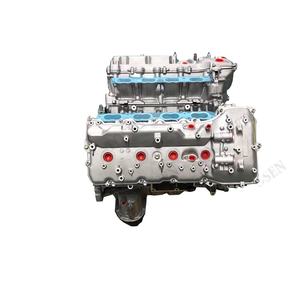Improve Your Experience with a High-Quality Opel Corsa Engine
Improve Your Experience with a High-Quality Opel Corsa Engine
Blog Article
Comprehensive Evaluation of a Subcompact Vehicle's Powertrain Capabilities
In the realm of auto design, the powertrain of a subcompact auto stands as an essential nexus where performance, efficiency, and development converge. From the engine's unrelenting quest of optimal performance to the transmission's smooth choreography of power distribution, every element plays a crucial duty in defining the total driving experience.
Engine Performance Analysis
In examining the engine performance of the subcompact automobile, a comprehensive analysis reveals its effectiveness and power result under various driving conditions. The subcompact auto's engine, an essential element of its powertrain system, demonstrates good efficiency metrics.
In addition, when subjected to extensive screening circumstances such as high-speed acceleration or uphill climbs up, the engine shows resilience and responsiveness. Its power output remains constant, supplying appropriate velocity when required. The subcompact car's engine is tailored to meet the demands of metropolitan driving, where quick acceleration and nimble maneuverability are vital.
In addition, the engine's layout incorporates modern technologies that enhance its performance characteristics. Features like turbocharging or variable valve timing add to improved power delivery and torque, enhancing the total driving experience. In conclusion, the engine efficiency of the subcompact automobile highlights its ability to provide effective and trusted power outcome throughout numerous driving conditions.
Transmission Performance Evaluation
Evaluating the subcompact auto's transmission effectiveness entails analyzing its performance in transferring power flawlessly throughout different driving problems. The efficiency of a transmission system is important as it straight influences the overall performance and fuel economy of the automobile. In reviewing transmission efficiency, elements such as gear ratios, change timing, and the smoothness of gear changes are thought about. A properly designed transmission system need to effectively deliver power from the engine to the wheels while reducing power losses.
One usual technique used to review transmission effectiveness is with dynamometer testing, where the power result from the engine is determined at the input and result shafts of the transmission. By examining these aspects, designers can determine areas for renovation and enhance the transmission system for better general performance and performance.
Gas Effectiveness Examination
The analysis of the subcompact auto's fuel performance entails an extensive evaluation of its usage prices under different driving problems. Fuel effectiveness is an important aspect in evaluating the total performance and cost-effectiveness of an automobile. By measuring the amount of gas taken in per unit distance took a trip, generally revealed as miles per gallon (MPG) or litres per 100 kilometers (L/100 km), the effectiveness of the subcompact vehicle's powertrain can be established.

Furthermore, innovations in modern technology, such as hybrid systems, regenerative braking, and automated start-stop systems, have considerably enhanced gas efficiency in contemporary subcompact cars and trucks. Makers proceed to introduce and maximize powertrain parts to improve gas performance while fulfilling efficiency needs and ecological laws. Reviewing a subcompact cars and truck's gas effectiveness gives useful understandings for consumers seeking sustainable and affordable transportation options.
Velocity and Handling Assessment
An essential facet of examining the performance capabilities of a subcompact cars and truck exists in analyzing its acceleration and handling characteristics. Velocity is critical as it figures out just how promptly the automobile can reach desired rates, influencing general driving experience and maneuverability in numerous traffic conditions. opel corsa engine. Subcompact automobiles are typically favored for their nimbleness and dexterity, making velocity from grinding halt and during overtaking maneuvers crucial aspects to think about
When it comes to taking care of, a subcompact auto's capacity to navigate edges, preserve security at broadband, and provide a responsive guiding feel are paramount. Limited city roads and winding roadways require exact managing to ensure chauffeur self-confidence and safety and security. Aspects such as suspension tuning, weight circulation, and tire hold play significant duties in figuring out a subcompact automobile's total handling prowess.

Powertrain Parts Overview
Upon diving right into the complexities of a subcompact auto's performance, a detailed exam of its powertrain components is necessary to grasp the automobile's mechanical supports. The powertrain of a subcompact vehicle normally is composed of the engine, transmission, driveshaft, differential, and axles. The engine, frequently a smaller displacement four-cylinder in a subcompact cars and truck, is in charge of generating power by burning fuel and converting the energy right into mechanical force. The transmission, whether manual or automatic, transfers this power to the wheels with the driveshaft. view The differential enables the wheels to revolve at various rates when turning, boosting maneuverability. Moreover, the axles send power from the differential to the wheels, making it possible for activity. Recognizing how these elements interact is vital in analyzing a subcompact car's overall efficiency, performance, and driving characteristics. In the following section, we will dig much deeper right into the certain functions and interactions of each powertrain component to provide an extensive summary of a subcompact vehicle's powertrain capabilities.
Verdict
To conclude, the subcompact car's powertrain capacities have actually been extensively evaluated in regards to engine performance, transmission performance, fuel effectiveness, handling, and acceleration. The thorough evaluation highlights the importance of each element collaborating flawlessly to provide optimal efficiency. In general, the powertrain elements of the subcompact car have actually been found to be efficient and healthy, making it a reliable option for vehicle drivers seeking a small and fuel-efficient vehicle.
In the world of auto engineering, the powertrain of a subcompact car stands as an important nexus where efficiency, technology, and efficiency converge.In evaluating the engine efficiency of the subcompact car, a comprehensive evaluation discloses its performance and power result under various driving conditions.Assessing the subcompact vehicle's transmission effectiveness includes assessing its efficiency in sending power flawlessly across numerous driving problems. Recognizing just how these components work together is important in examining a subcompact cars and truck's general performance, effectiveness, and driving dynamics.In conclusion, the subcompact vehicle's powertrain capabilities have actually been extensively examined in terms of engine performance, transmission performance, gas handling, efficiency, and acceleration.
Report this page